GEOG 2511: Principles of Sustainability - Oral Exam 2
1/39
There's no tags or description
Looks like no tags are added yet.
Name | Mastery | Learn | Test | Matching | Spaced |
|---|
No study sessions yet.
40 Terms
List and explain the four types of environmental hazards
1. Physical Hazards
2. Chemical Hazards
3. Biological Hazards
d. Cultural Hazards
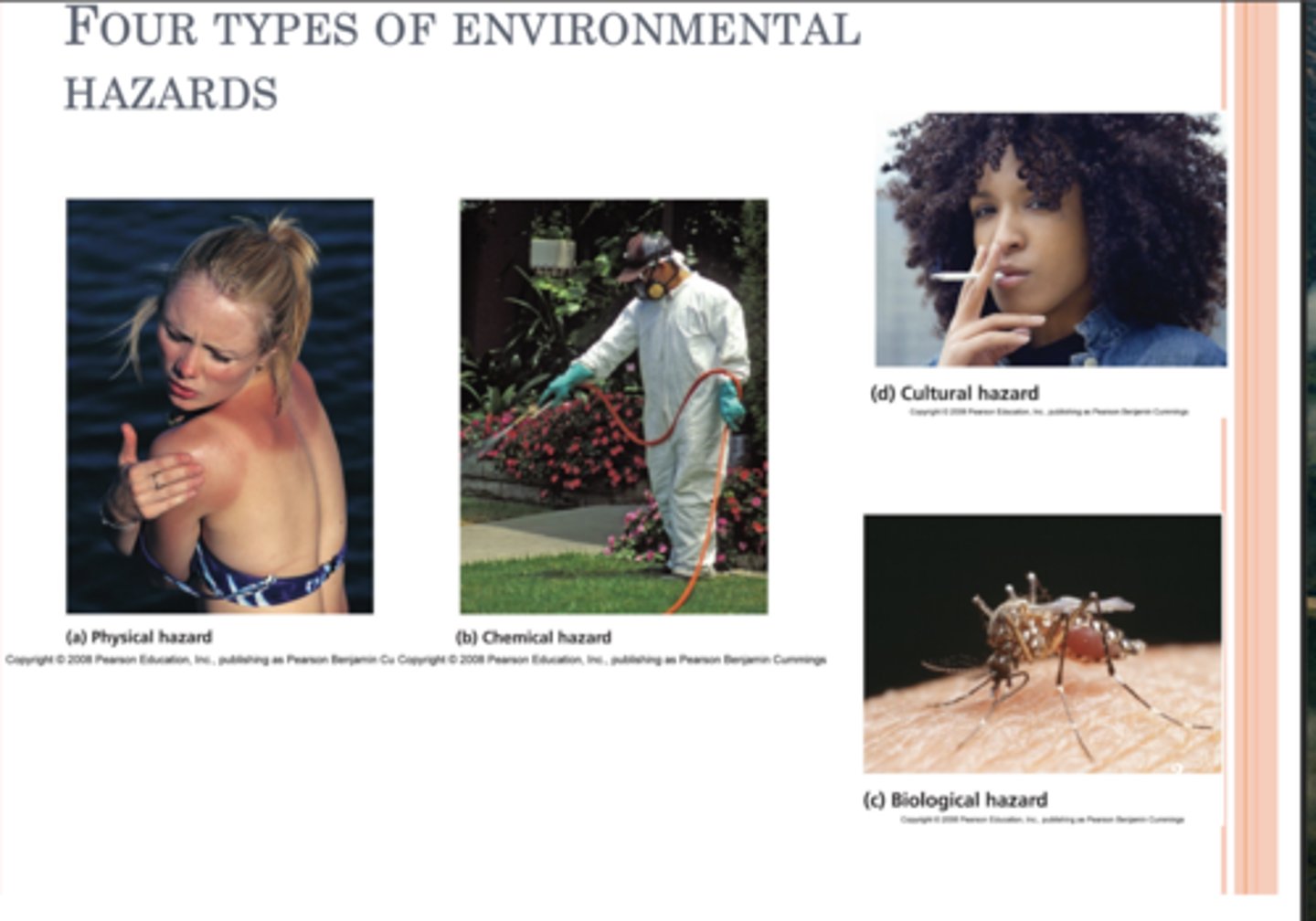
Physical Hazards
Physical dangers that occur naturally in our environment.
Ex:
- Natural disasters
- Volcanoes, fires, floods, droughts.
- Can't prevent, can prepare
Chemical Hazards
Synthetic chemicals such as pesticides, disinfectants, and pharmaceuticals
Natural chemicals such as smoke, poisions, and venous animals.
We can create medicines for these, but we can also prevent dangerous synthetic ones from damaging us and our ecosystems.
Biological hazards
Viruses, bacteria, pathogens. Interactions with a infectious disease.
Cultural Hazards
Habits or conditions that humans created and sustain in our culture. These result from the place we live, our socioeconomic status, occupation, and behavioral choices.
Ex: Smoking, littering, tolerance for pesticides and GMOS, etc.
What are Persistent Organic Pollutants?
POPs
Degrade slowly
Toxic, carbon-based chemicals that resist degradation and decomposition through chemical, biological, and photolytic processes (being broken down by the sun or protons.)
Accumulate in fatty tissues
- Accumulate in fatty tissues (brain, liver, fat) of animals at the bottom of the trophic level, including phytoplankton and insects.
- As a result, humans and animals at the top of the food chain, such as fish, predatory birds, and mammals, are exposed to the highest levels of these pollutants
Exposure:
+ cancer risk
+ developmental disorders
+ damage to reproductive, endocrine and immune system
Examples:
DDT, PCB's, etc.
POP's are valued because of their resilience. PCB was an industrial chemical used in plastics.
Where are POP's most common?
Animals products, especially the meat of animals we eat and eggs.
The picture is from a study in Korea about where the most dangerous synthetic chemicals are found.
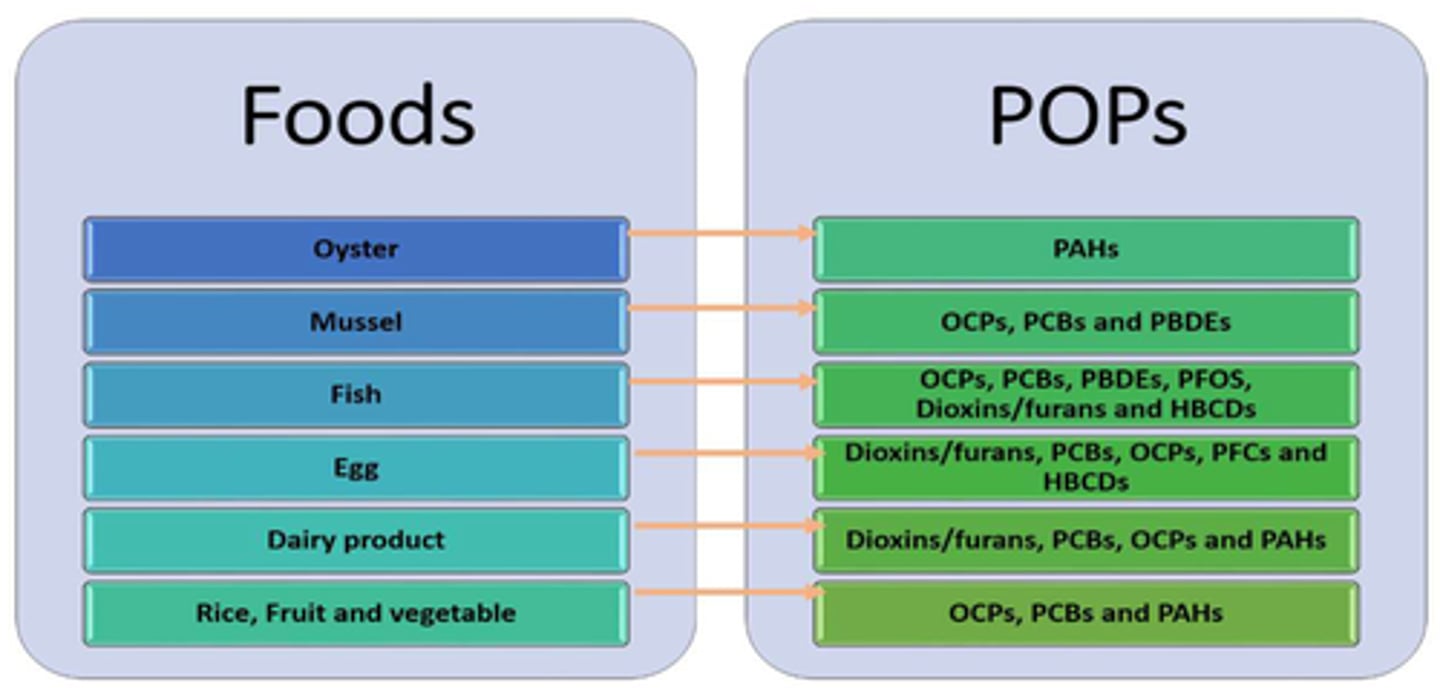
What are the impacts of POPs on humans?
POP's can damage various important systems in humans through an effect called bioaccumulation. A sustained exposure to POP's due to our food supply being infected leads to...
Reproductive System:
- reduced sperm quality and infertility
- development abnormalities
- hormonal disruptions
Nervous system:
- Cognitive motor deficits
- Spinal problems
- Headaches and life-long migranes
What are the impacts of POPs on the environment?
Bioaccumulation: the build up of POP's in an organisms tissues over time.
Biomagnification:
The increase in concentration of POP's at each successive level of the trophic pyramid
Individual Impacts:
- impaired fertility, developmental abnormalities, shifts in sex ratios, and physical deformities.
Effect on fertility:
- In male vertebrates, POPs can cause the abnormal production of female egg yolk protein (vitellogenin), a clear sign of feminization. (resulting in intersex conditions)
- can reduce the number and quality of offspring
Widespread Contamination: POPs resist environmental degradation and can be transported by wind and water over long distances, leading to their accumulation in regions far from their original sources, such as the Arctic and Antarctica
Ecosystem Disruption: The toxic effects of POPs can disrupt ecosystem balance by affecting key species, altering predator-prey relationships, and reducing biodiversity.
Climate Change Interactions: Climate-driven changes, such as ice melt and altered sediment dynamics, can remobilize stored POPs, increasing their availability and uptake by organisms, and potentially exacerbating their toxic effects in sensitive ecosystems
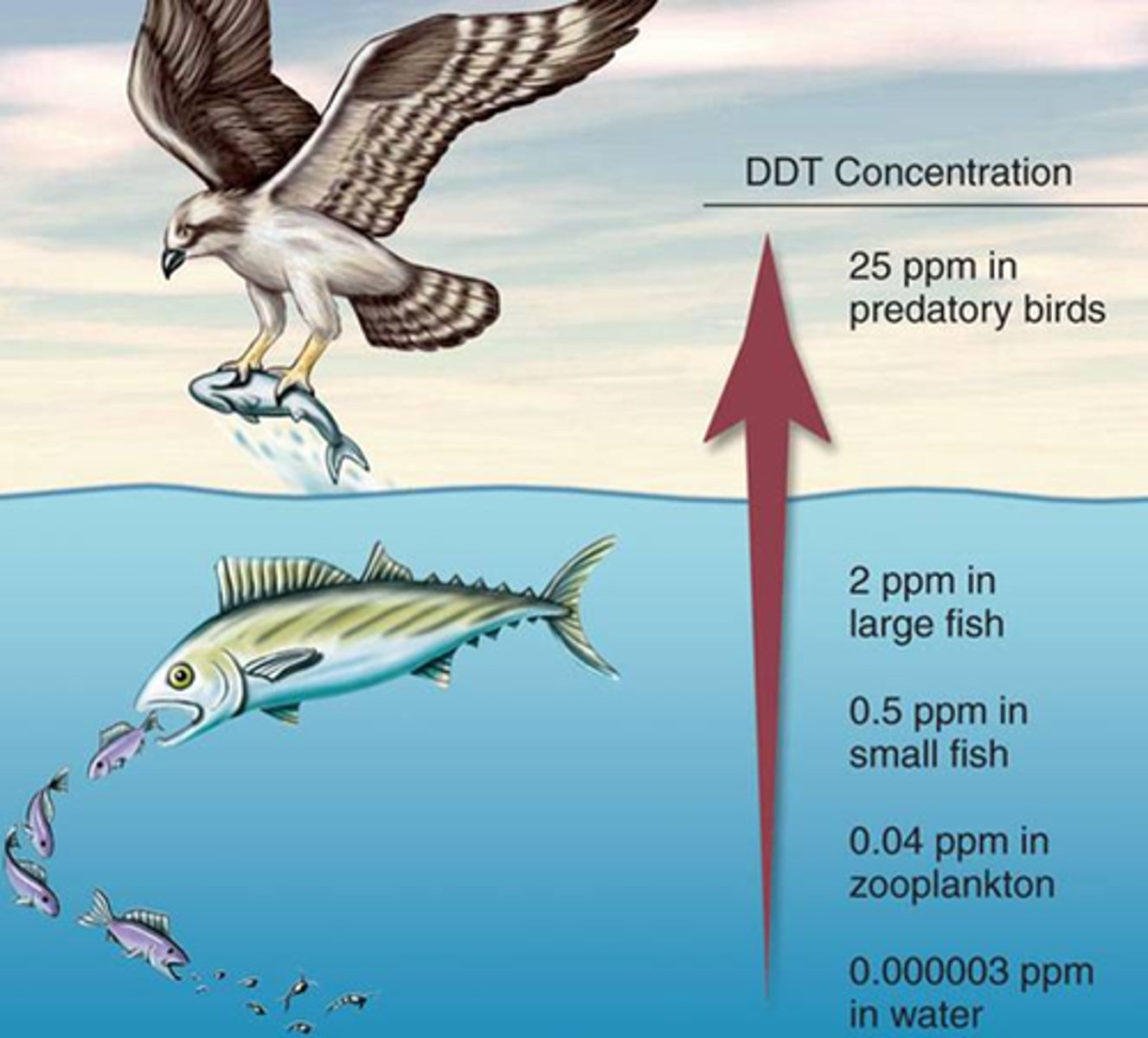
DDT
A powerful insecticide that is also poisonous to humans and animals. Example of a Persistent Organic Pollutant that can bioaccumulate and effect the fatty tissues of animals up the trophic pyramid.
What is the Stockholm convention? Why is it relevant?
- Based in Geneva, Switzerland
- Adopted in 2001, Began enforcement in 2004
- Treaty requires parties to remove or minimize release of P.O.P.s
Scope: Originally targeted 12 POPs (the "dirty dozen"), but the list has expanded over time as new chemicals meet the criteria for persistence, bioaccumulation, long-range transport, and toxicity
Broke the chemicals up into Annex A,B,C.
Annex A: Chemicals to be eliminated.
Annex B: Chemicals to be restricted.
Annex C: Chemicals for which unintentional production should be minimized
As of recent updates, there are 186 parties to the Convention, including most countries and the European Union
Dirty Dozen
12 chemicals identified by the Stockholm Convention in 2000 that can accumulate in fatty tissues of humans and other organisms that occupy high trophic levels in food webs.
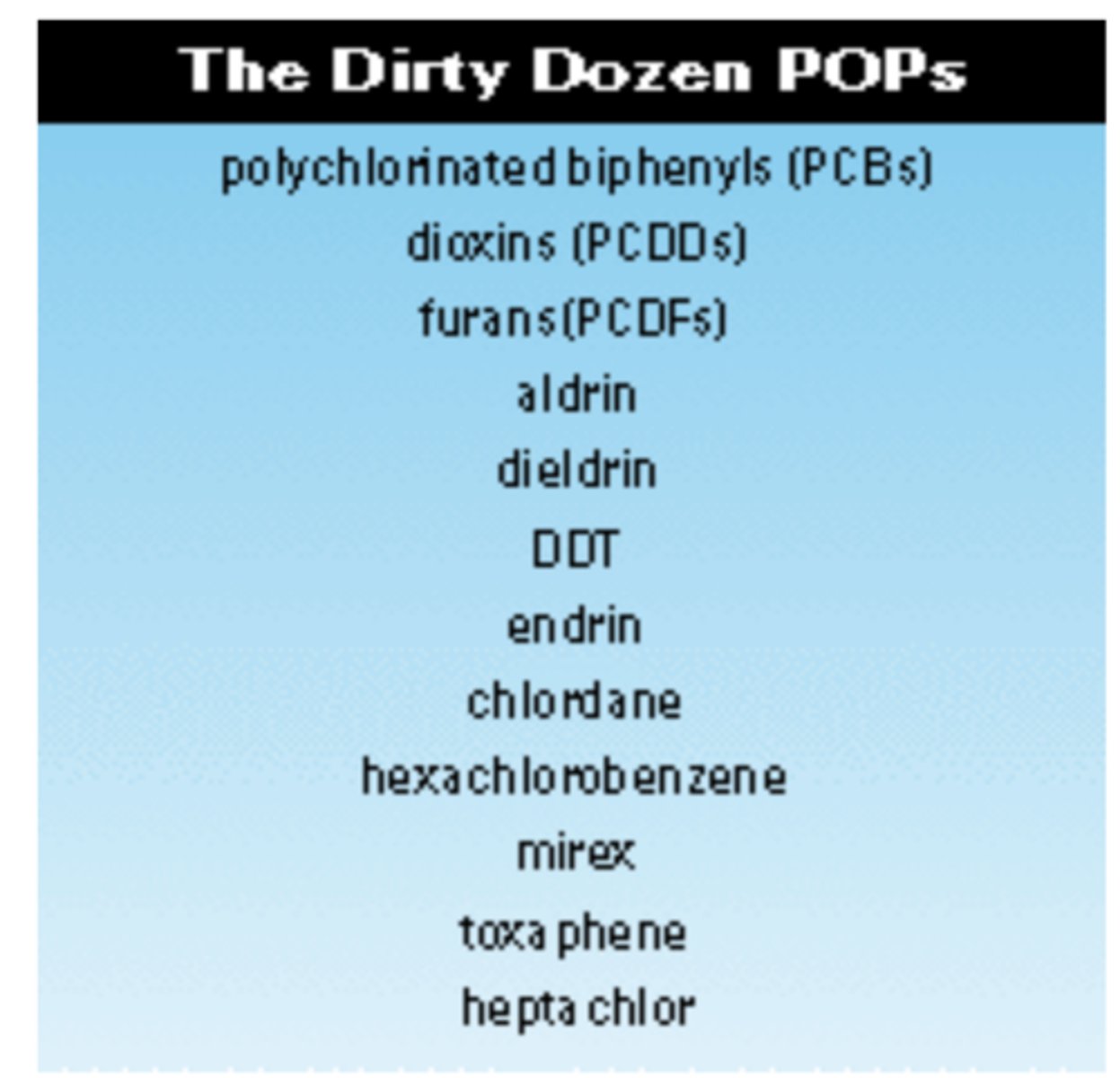
List and explain 2 POPs (choose and conduct your own research)
DDT
Aldrin
DDT
Origin:
DDT was introduced as a broad-spectrum insecticide in the 1940s and became widely used in agriculture and public health to control malaria-spreading mosquitoes and other pests
- travels through air and water
Effects:
- Chronic exposure to DDT has been linked to breast cancer, diabetes, decreased semen quality, spontaneous abortion, and impaired neurodevelopment in children
- Acute exposure can cause symptoms such as tremors, headaches, nausea, and seizures
Environment:
- DDT is particularly notorious for its impact on bird populations, causing eggshell thinning and reproductive failure, most notably in species like the bald eagle and peregrine falcon
- Its persistence and bioaccumulation
Stockholm:
- Annex B
- Restricted its production and use to disease vector control (e.g., malaria prevention), with strict reporting and monitoring requirements
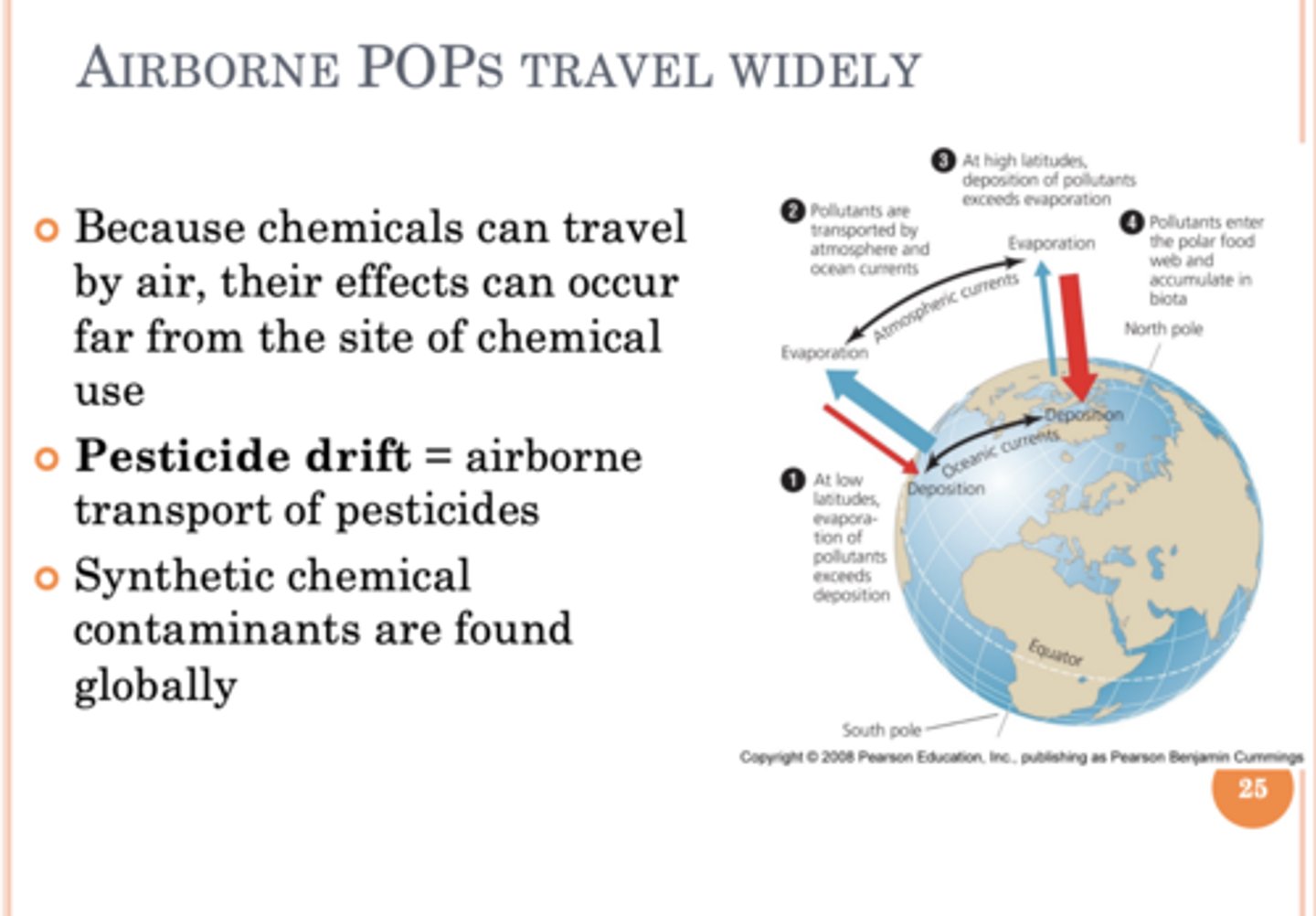
Aldrin
origin:
- Aldrin was developed as an organochlorine insecticide and was widely used to control soil pests in agriculture and for termite control
Effect:
- Exposure to aldrin is associated with neurotoxicity, including tremors, convulsions, and central nervous system effects. Chronic exposure may increase the risk of cancer and disrupt endocrine function
Environment:
- Aldrin (and its breakdown product dieldrin) is toxic to birds, fish, and other wildlife, causing mortality and reproductive effects
- leads to declines in sensitive species
Stockholm:
- Annex A
- production and use are to be eliminated, with no exemptions for ongoing use
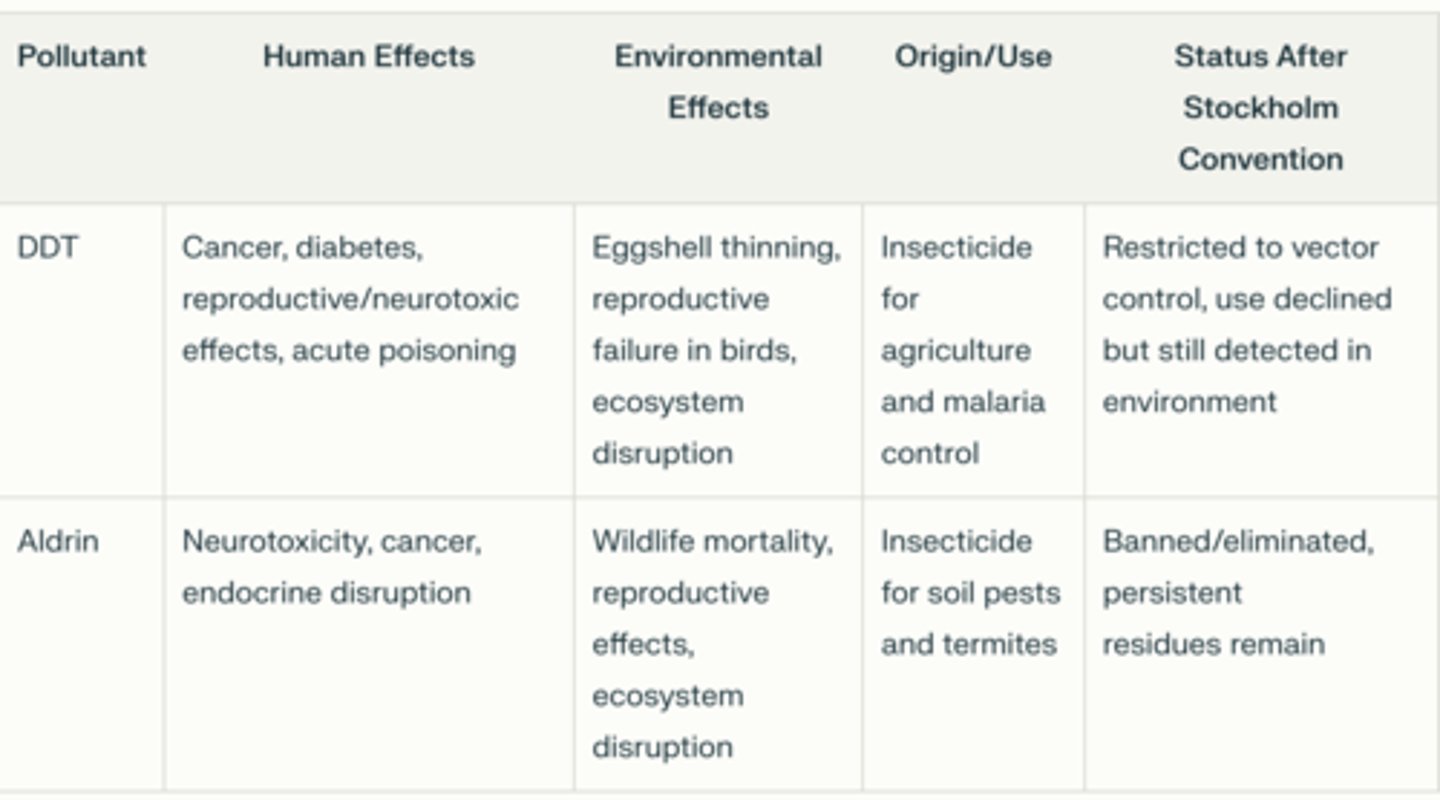
Explain the legacy of Rachel Carson's book "Silent Spring" in our understanding of POPs impacts
1962 book by Rachel Carson that started the environmental movement
Explain the precautionary principle approach and its possible implications on U.S. economy
When an activity raises threats of harm to human health or the environment, precautionary measures should be taken even if some cause and effect relationships are not fully established scientifically.
In the U.S, instead of the pro-active approach, we use the re-call appraoch.
U.S. Economy:
- Examine a product's chemical components to ensure it isn't environmentally dangerous before it enters the market
- This can slow down the release of new products, but ensures we don't have to do massive recalls.
- If we used this approach, products could stay on shelfs for longer and be used more universally.

Case study: Yaqui children in Mexico - Developmental Delays. Explain in detail
Yaqui children in Mexico have been the focus of significant research due to the severe developmental delays and neurobehavioral effects observed as a result of chronic pesticide exposure in the Yaqui Valley
Elizabeth Guillette compared children living in the agricultural lowlands—where pesticide use is heavy—to those in the foothills, where pesticide use is minimal. Despite sharing similar genetic backgrounds, diets, and cultural practices, the two groups showed striking differences in development
Motor and Cognitive Impairments: Children from the pesticide-exposed valley had much greater difficulty with tasks requiring hand-eye coordination,
Behavioral and Social Effects: Valley children were more likely to display aggressive behaviors, such as striking others without provocation, and were easily upset or angry. They also showed less creativity in play and were less interactive in group activities
Drawing Ability: When asked to draw pictures of people, foothill children produced recognizable figures, while valley children’s drawings were often infantile scribbles, indicating developmental delays
Other Health Effects: In addition to developmental delays, exposed children experienced physiological symptoms such as skin burns, loss of fingernails, and rashes. In some cases, exposure led to death
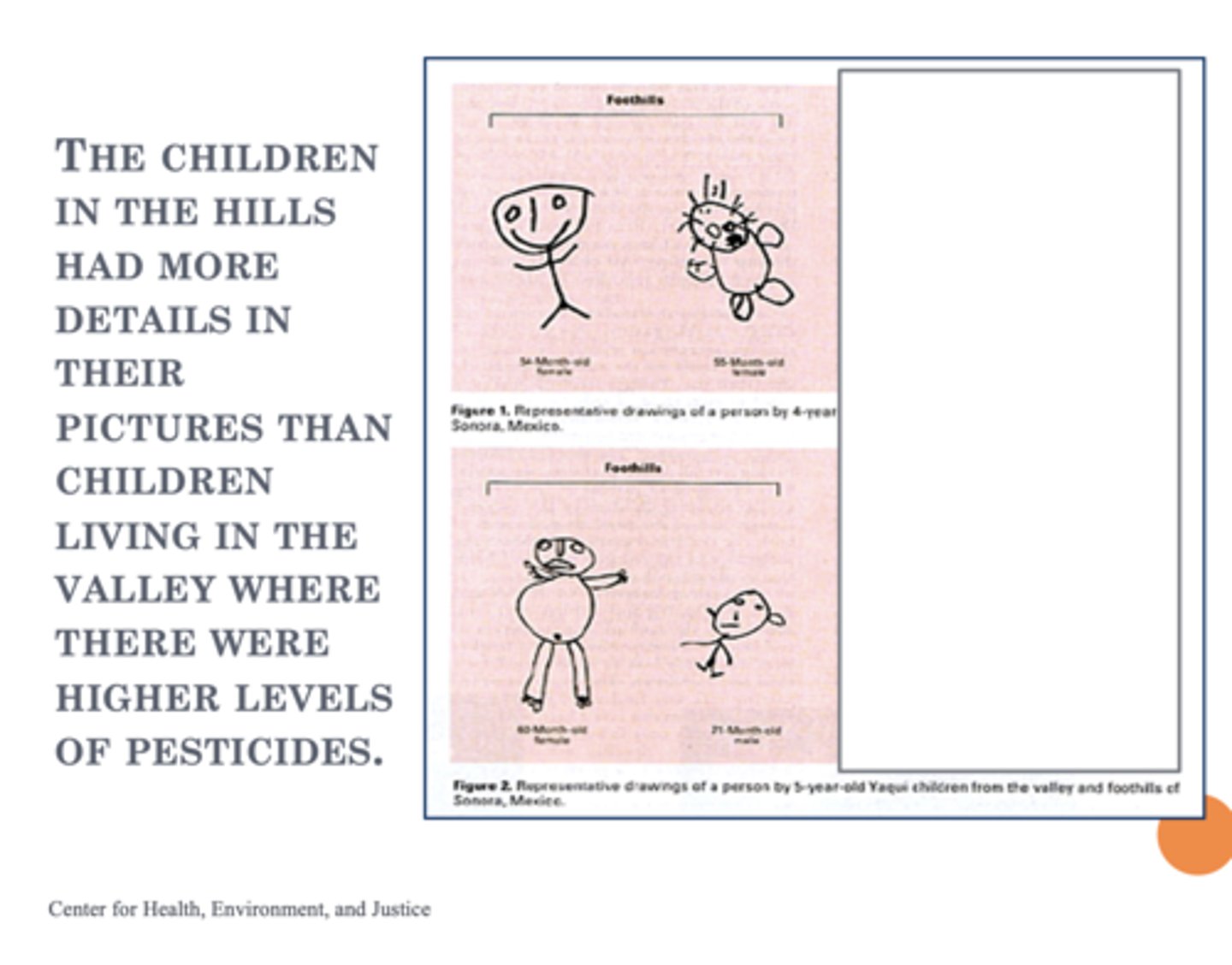
Role of pollinators in the environment, what ecosystem services do these provide
- Over 80% of the world's flowering plants rely on pollinators in order to reproduce
- $34 billion value of the impact of insect pollinators
- 35% of food crops around the world depend on pollinators
- Supports other ecosystem services, including biodiversity, plant growth, soil erosion prevention, and carbon sequestration.
- There are 4,000 species of wild bees in the US. 946 native to Colorado
We want to protect our pollinators, and one way we can do that is by ensuring POP's are not prevalent in the environment.
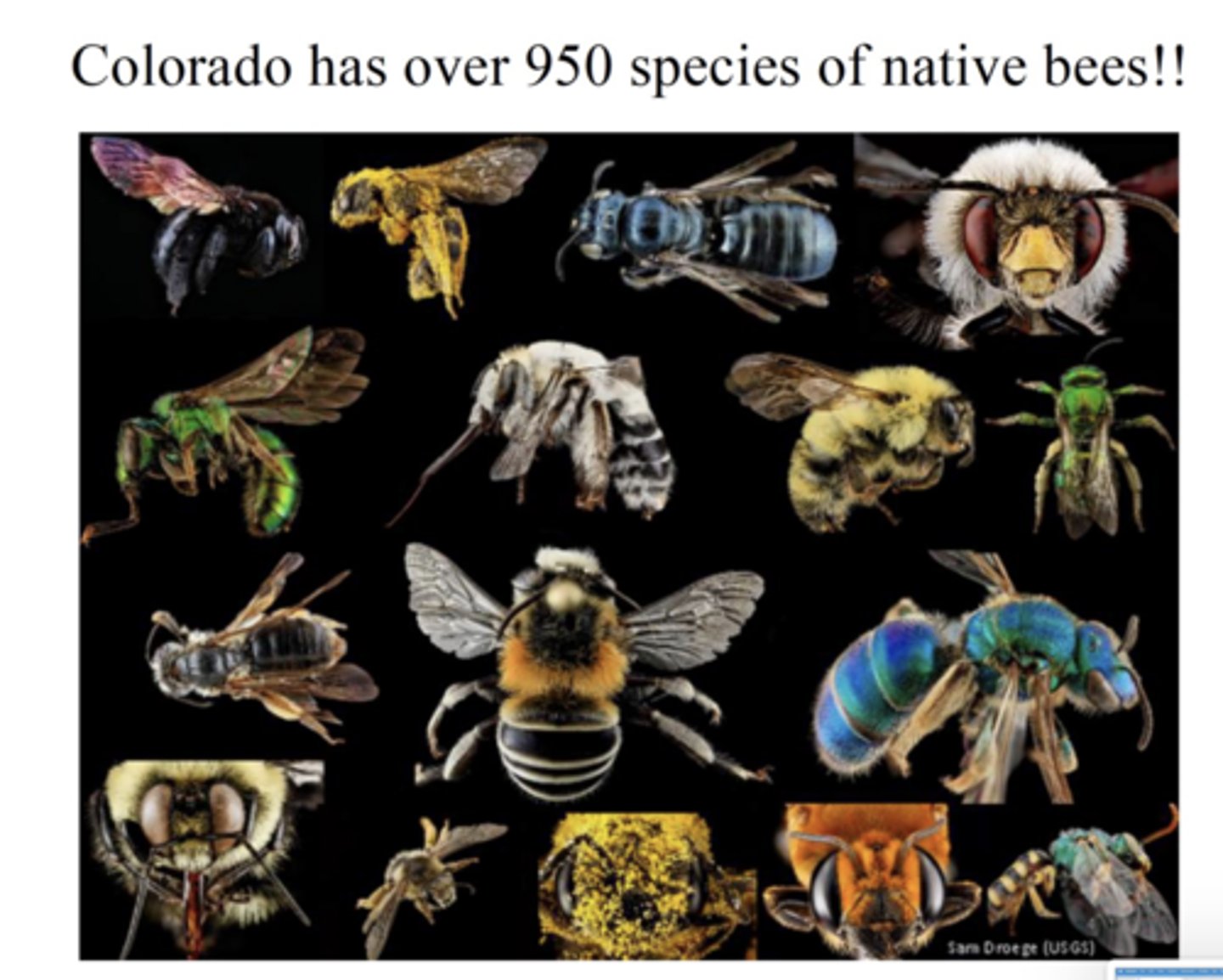
Types of pollinators - importance of native bees
Types of Pollinators:
Bees, Butterflies/Moths, beetles, flies, birds, bats, and some small mammals and reptiles.
Honey Bees vs. Native Bees
+ honey bees = - native bees
- Honey Bees can set up in areas that have been cleared of native plants and bees
- Honey bees can carry harmful pathogens and diseases to native bees
- Honey bees are very aggressive in nature when compared native ones, and often beat up or attack native ones.
- Resources for honeybees leaves Native bees are left to fend for themselves under drought, freeze -thaw, fire cycles
Native Bees are Cool
- Native bees are more attracted to a variety of Colorado's fauna, whereas Honey Bees are attracted to only certain kinds of flowers.
- Native bees are simply more suitable to Colorado's unique ecosystem
Based on the West Word_2025 article "Saving Colorado's Native Bees" explain the 'conflict' between honeybees and native bees
https://www.westword.com/news/colorado-native-bees-suffer-as-honey-bee-protected-24410551
Of the 20,000 species of bees worldwide, at least 1,000 live in the Colorado
Don't save the honey bee:
- Native bee populations, which play crucial ecological roles, are undergoing a steep decline that is only aggravated by the presence of honey bees.
- “Honey bees don't need to be saved," Montoya insists.
- Honey bees were introduced when European settlers brought them over
- Native bees cannot fly as far as honey bees
Before honeybees:
Some native food sources, such as cherries, blueberries and cranberries, were pollinated by native bee species. Other species, like cereal grains, were wind-pollinated.
Can honey bees replace native bees?
NO!
A recent National Library of Medicine study found that more honey bees in an area equate to fewer wild bee species.
1. Honey beekeepers can set up shop in urban and agricultural areas that have been cleared of native trees and other plants. Without those food sources, a habitat can’t support as many native bees, which don’t fly as far as honey bees for food.
2. Honey bees can pass harmful pathogens like vorroa mites, a contributor to colony collapse, to other bee species.
3. Honey bees are aggressive
What are specific challenges that native bees face in Colorado?
1. Urban Sprawl (Loss of native prairie land)
3. Changing climate = shorter and more intense snowmelt season.
4. More intense storms from climate change and weather unpredictability = Disruption of the timing of plant flowering and reduce the availability of nectar and pollen, which are critical food sources for bees
5. Competition of non-native species
Many native bee species are specialists, relying on specific native plants for pollen and nectar. The loss of these host plants due to habitat destruction or climate change can quickly lead to the decline or extinction of specialist bee populations
Explain the historic evolution of Earth's oceans
Video: https://www.youtube.com/watch?v=AUAEBjlROWQ
1. Earth in its early stages was mostly molten rock (gathered up space debris) with low gravity, and mostly hellium and hydrogen in the atmosphere.
2. Over time, Earth did begin to cool down (as heat escaped into the solar system because there was no atmosphere)
3. Ocean's Formed
- The oceans formed about 4.2 billion years ago when the Earth's surface cooled below 212 degrees Fahrenheit. The water vapor in the atmosphere condensed and fell as rain. This rain filled the low-lying basins of the Earth, which became the oceans.
3. Volcanos formed - erupted, spewing Co2 and Nitrogen.
4. Oxygen formed -
U.V. Radiation breaks down Co2 to release oxygen
5. Cyanobacteria (a group of
photosynthetic
bacteria that live in water)
photosynthesize Co2 to release oxygen
6. OZONE FORMS!!!
- Ozone formed in the stratosphere when UV Radiation interacted with oxygen molecules Volatile Organic Compounds (VOC), which are also known as Hydrocarbons.
List and explain 3 vital marine processes and properties
1. High Heat Capacity of Water
- 90% of the UV radiation from the sun that is being trapped in the troposphere is absorbed by the ocean
2) Latent heat of vaporization
- The latent heat of vaporization (also called the enthalpy of vaporization) is the amount of energy required to change a given quantity of a liquid into a gas at a constant temperature and pressure.
- Water has a very high latent heat level, this means it takes A LOT of energy to warm up the ocean.
- The ocean acts as a weather and climate regulating force
3) Snow and Ice Climate Feedback Loop
COOLING: if the Earth is in a cooling period, with expanding ice and snow, more UV energy will be reflected. This mean's less energy is present to melt the ice, and therefore, allowing the ice to expand.
WARMING: On the other hand, when warming causes snow and ice to melt, darker colored Earth surfaces and ocean are exposed and less solar energy is reflected out to space. This process causes even more warming and is known as the ice-albedo feedback loop.
4) Oceans Produce 50% of our Oxygen and Absorb 25% of our Co2
How Oceans Produce 50% of Earth’s Oxygen
- The vast majority of oxygen production in the ocean comes from microscopic marine algae, called phytoplankton, as well as seaweed and cyanobacteria. These organisms live in the sunlit upper layer of the ocean (the photic zone)
- Phytoplankton and marine algae photosynthesize, producing oxygen as a by-product
How Oceans Absorb 25% of Human-Generated CO₂
- Phytoplankton and other marine plants use CO₂ during photosynthesis
- Carbonate System: Dissolved CO₂ reacts with water to form carbonic acid, which then dissociates into bicarbonate and carbonate ions. This process helps the ocean absorb more CO₂ and buffers the effects of rising atmospheric CO₂ levels.
- leads to ocean acidification
How does climate change affect our oceans?
Climate Change means our oceans are absorbing more heat, and also gaining mass as glaciers melt.
- Ocean Acidification: The ocean absorbs about 25–30% of human-emitted CO₂, which reacts with seawater to form carbonic acid, lowering the pH. This acidification weakens the shells and skeletons of marine organisms such as corals, mollusks, and some plankton, disrupting the entire food web. + Co2 = + ocean acidification
- Loss of Oxygen (Deoxygenation): Warmer water holds less oxygen, and increased stratification reduces mixing, leading to low-oxygen zones. This can suffocate marine life and create "dead zones"
- Disruption of Ocean Currents: Melting ice and changing temperatures and salinity alter the density and movement of ocean currents. This can disrupt global climate patterns, affect weather systems, like the El Nino/El Nina system, the Gulf Stream, and Ocean Conveyor Belt System.
- Biodiversity Loss and Ecosystem Shifts: Warming, acidification, and habitat loss lead to declines in species, shifts in distribution, and changes in the timing of biological events. Coral reefs, in particular, are highly vulnerable: up to 90% may disappear if global temperatures rise by 1.5°C
Impacts on Fisheries and Human Livelihoods: Changes in species distribution and abundance affect fisheries, threatening food security and the livelihoods of coastal communities
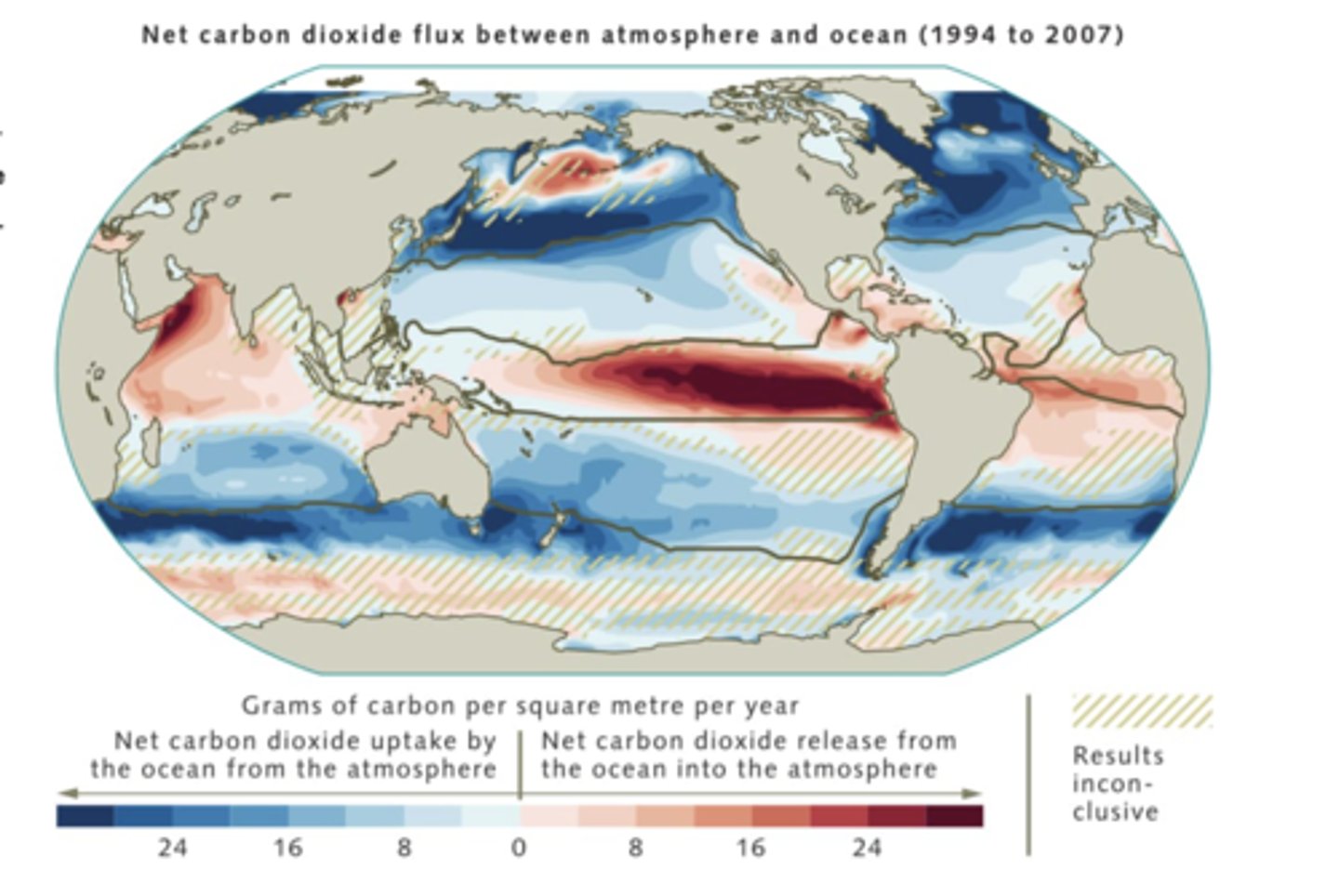
What are the most important Oceanic Currents?
Gulf Stream:
- Atlantic Ocean, from the Gulf of Mexico to the North Atlantic.
- Transports heat from the tropics to northern regions, like Western Europe.
- This is why Canadian cities are pretty mild during the summer, but Spain, England and France can be STIFFLING.
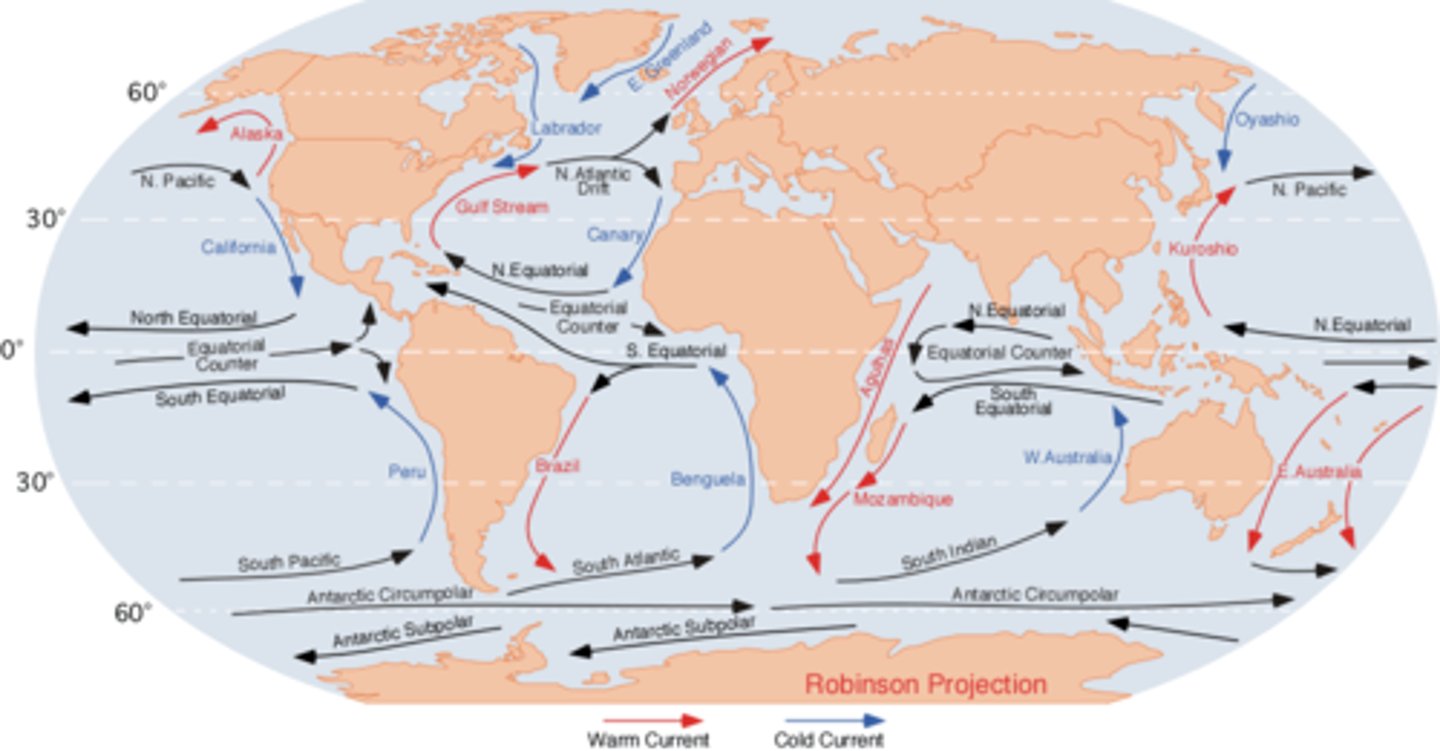
Explain the issue of ocean pollution from non-natural contaminants
"Non Natural Contaminants" =
- Plastics
- Industrial chemicals (heavy metals, POPs, and oil spills)
- Nutrient pollution (excess nitrogen and phosphorus)
- Sewage and Wastewater
Plastic is the most widely used human made substance in the world. Low and high incomes generate an enormous amount of plastic waste, (with high income countries generating far more.)
High income regions:
- Fishing related materials = 1/3 of pollutants
- High income countries have a hard time controlling industrial/capital waste far from the mainland
Low income regions:
- Food container/food waste materials.
- Low income countries have a hard time managing smaller, day to day waste
Microplastics
- Accumulate in ocean water, and then marine life (bioaccumulate)
- Metabolically toxic
- transfer from one living organisms to another (mother to baby) & (consumed to consume)
Explain the concept of ocean acidification and its consequences
H20 + Co2 = H2Co3 (Carbonic Acid)
The oceans are still slightly basic (current pH 8.1) only less so due to this acidification. This causes calcification challenges for corals, mussels, and some phytoplankton & zooplankton.
Ocean Acidification is the process of excess Co2 being absorbed by the ocean, dissolving in seawater and reacting to become carbonic acid. Carbonic acid, in excess, damages the outer membranes and shells of ocean vertebrates and invertebrates, which exposes them to oceanic currents, shortens their lifespans and damages the basis of ocean ecosystems.
Surface water contains carbon in 3 different ways:
1. Co2 - 1% - this can released into the atmosphere again. Determines the partial pressure of carbon dioxide for the seawater;
2. Hydrogen Carbonate - 90%
3. Carbonate
---
Human Activities: The main driver is the burning of fossil fuels (coal, oil, natural gas), which increases atmospheric CO₂ levels. Deforestation and land-use changes also contribute by reducing natural CO₂ absorption.
Natural Factors: Some natural processes, like volcanic activity, can temporarily affect ocean acidity, but their influence is minor compared to anthropogenic CO₂ emissions.

Explain the problem of overfishing
Overfishing: When humans catch faster than they can naturally stabilize and replace their population.
Fishing stocks have seen a 90% decrease from 1950 to 2011.
Approximately 77.9 billion tonnes of fish are caught annually
Only 1% of ocean habitats are in recovery from overfishing, while 52% are being fully exploited.
What makes industrial fishing so unsustainable? How did we get here?
1. Method
- the nets commercial fishing boats are massive, and can hold 13 jumbo jets. These nets can hold 500 tonnes of fish, and often crawl along the ocean floor, or float in discriminatorily across the ocean.
2. Bycatch
- When an animal, coral, or plant is caught but not the desired product, it is put back into the ocean, probably more dead than alive.
- For every 1kg of shrimp, there is 8-9kg of bycatch.
- 50% of all swordfish caught are tossed back. 77% of those swordfish died in the net.
3. Tragedy of the Commons
- Many global fisheries were, or are being overfished. This means that there is either no chance or a very low chance these fisheries can recover and be used sustainably in the future.
4. The Dark Fishing Industry
- The illegal fishing industry is massive and occurs because prized catchers, such as large bluefin tuna, can catch high prices.
- We fish approximately 10x more of the bluefin tuna population than scientists recommend we should.
Economic Problem:
- we are rapidly depleting fishery stocks
- The commercial fishing industry is a luxury business, and does not contribute to global food security
Benefits of closing the high sea to fishing (Provide arguments in favor of Marine Protected Areas (MPA)
The potential benefits for closing all of the High Seas to fishing stem from giving the natural marine ecosystems the time and space to recover fully.
Anthropogenic intervention from industrial fishing practices have torn up thousand year old coral reefs and disrupted the delicate balance of nutrient cycling in the ocean. As seen in previous studies and experiments, oceanic ecosystems are incredibly resilient and can return to an abundance in biodiversity and species richness in a relatively short period of time.
Not only would banning this exploitative and unprofitable industry end a mechanism for forced labor and excessive government spending in the world, but it would create a more profitable relationship with the ocean via eco-tourism. As stated in the video, coastal ecosystems within the 200 nautical boundary are more productive and more profitable.
It is important to reallocate government funds to create eco-tourism opportunities that educate people about the natural beauty and vital ecosystem services these ecosystems provide.
This could generate an enormous amount of high paying jobs, ranging from tour guides (which is a much safer job than working on a marine shipping vessel), to coastal sustainability scientists.
Additionally, those government subsidies could be re-allocated to local fishery operations that do strongly contribute to the global food supply, such as internal tributaries and rivers that also need vital financial support and management.
Most importantly to combat climate change, as marine ecosystems recover, the ocean's function as a carbon sink will increase because carbon-capturing ecosystems such as kelp forests, coral reefs, and deep oceans will recover. This will also increase the photosynthesis rate from the ocean, ensuring the globe's oxygen supply remains intact.
Explain the controversies behind aquaculture
Aquaculture faces several controversies, including concerns about environmental damage, the use of wild-caught fish for feed, potential health impacts, and the welfare of farmed fish.
Aquaculture
- Aquaculture accounts for 50% of the world's fish supply.
- Releases marginally less GHG than wild caught fish
- Rely on antibiotics to keep disease at bay
- Need to feed the fish something, which is usually wild caught or farmed shrimp. (So like, what is the point?)
Habitat Destruction:
Construction of aquaculture facilities can destroy or damage coastal habitats, including mangroves and wetlands, which are important for biodiversity and coastal protection.
Pollution:
Aquaculture operations can release pollutants, such as feed, waste, and chemicals (including antibiotics and biocides), into the surrounding water, leading to eutrophication, reduced water quality, and potential harm to other marine life.
Escapement and Cross-Breeding:
Farmed fish can escape their enclosures and interbreed with wild populations, potentially leading to genetic contamination and ecological disruption.
Reliance on Wild Fish:
.Opens in new tabMany aquaculture practices, especially for carnivorous fish like salmon, require large amounts of wild-caught fish to produce fish meal, which raises concerns about the sustainability of wild fisheries and the net loss of protein.
Lower Nutritional Value:
Farmed fish may contain lower levels of protein and essential fatty acids compared to wild fish, and they may also have higher levels of fat.
How did the leadership styles of Mockus and Peñalosa differ, and how did each contribute to the city's transformation?
Mayors of Bogotá in the early 100s
Antana Mockus:
Mockus was the perfect candidate to enter the Bogotá political scene in the early 2000s because he was radical, compassionate, and completely independent from political corruption and norms.
Life is sacred: Ran on a platform that Bogota needed to change its culture to protect all life.
Educational & Symbolic Leadership: Mockus, a mathematician and philosopher with no prior political experience, approached the city as a “large classroom,” aiming to educate and engage citizens rather than simply enforce laws
- Creative and participatory incentives = civic pride, safety. He used art, humor, and his own presence as a way to demonstrate the desired cultural changes that helped Bogota become a safer place.
- I really think his funny and unconventional approaches, like mimes, Supercitizen, and slapping politicans with water, broke a seal of seriousness and fear that was cast over Bogota. People could be like, "Haha! Okay I guess I'll try."
- Clear, direct communication. It was often Mockus demonstrating desired social changes, and he came up with the red and white card system.
Enrique Penalosa:
- Infrastructure-Focused and Pragmatic Leadership: Peñalosa, an economist and urbanist, prioritized tangible improvements to the city’s physical and social infrastructure
- Equality and Public Space: He championed projects that reclaimed public spaces for all citizens, such as constructing parks, libraries, and the TransMilenio bus rapid transit system, and implementing strict protections for green spaces
Both:
- Ran as independents
- Hired their cabinets based on merit
- Believed in the mayoral platform as a tool to make the lives of citizens better, did away with political favors.
Mockus Unconventional Tactics
Are the changes implemented during this period sustainable in the long term? What challenges might arise in maintaining them?
1. Mimes for traffic and to demonstrate ideal civic behaviour
2. Ladies night
3. Bar curfew at 1am
4. Ladies Night
5. Super Citizen
6. Taking a shower on TV to demonstrate water conciousness
Yes, they are sustainable because they created a cultural shift towards order and protecting life. This change also let Pensalosa's ideas be sustainable.
What lessons can other cities learn from Bogota's transformation? Are these lessons universally applicable or context-specific?
Emphasize leadership that demonstrates a cultural shift you want to see in the people. This is applicable to every city. We see it today in America, for the worst.
What are the challenges of managing Municipal Solid Waste
MSW = Total of all materials (trash, refuse, garbage)
- 22% food waste
- 23% paper
- Positive correlation next between GDP per capita and MSW
Landfills: Waste is put into the ground and then covered with soil, but in the past this was done without consideration of layers, ecology, water cycle, or products of decomposition.
Non-hazardous Industrial Waste: Generated by industries
Fresh Kills, New York
The Fresh Kills Landfill was a landfill covering 2,200 acres in Staten Island, NY
The landfill opened in 1948 as a temporary landfill, but by 1955 it had become the largest landfill in the world, and it remained so until its closure in 2001.
The Fresh Kills site was transformed into reclaimed wetlands, recreational facilities and landscaped public parkland, the most significant expansion of the New York City parks since the development of the chain of parks in the Bronx during the 1890s.
The new park was designed by James Corner Field Operations, the landscape architecture firm also responsible for the design of the High Line in Manhattan.
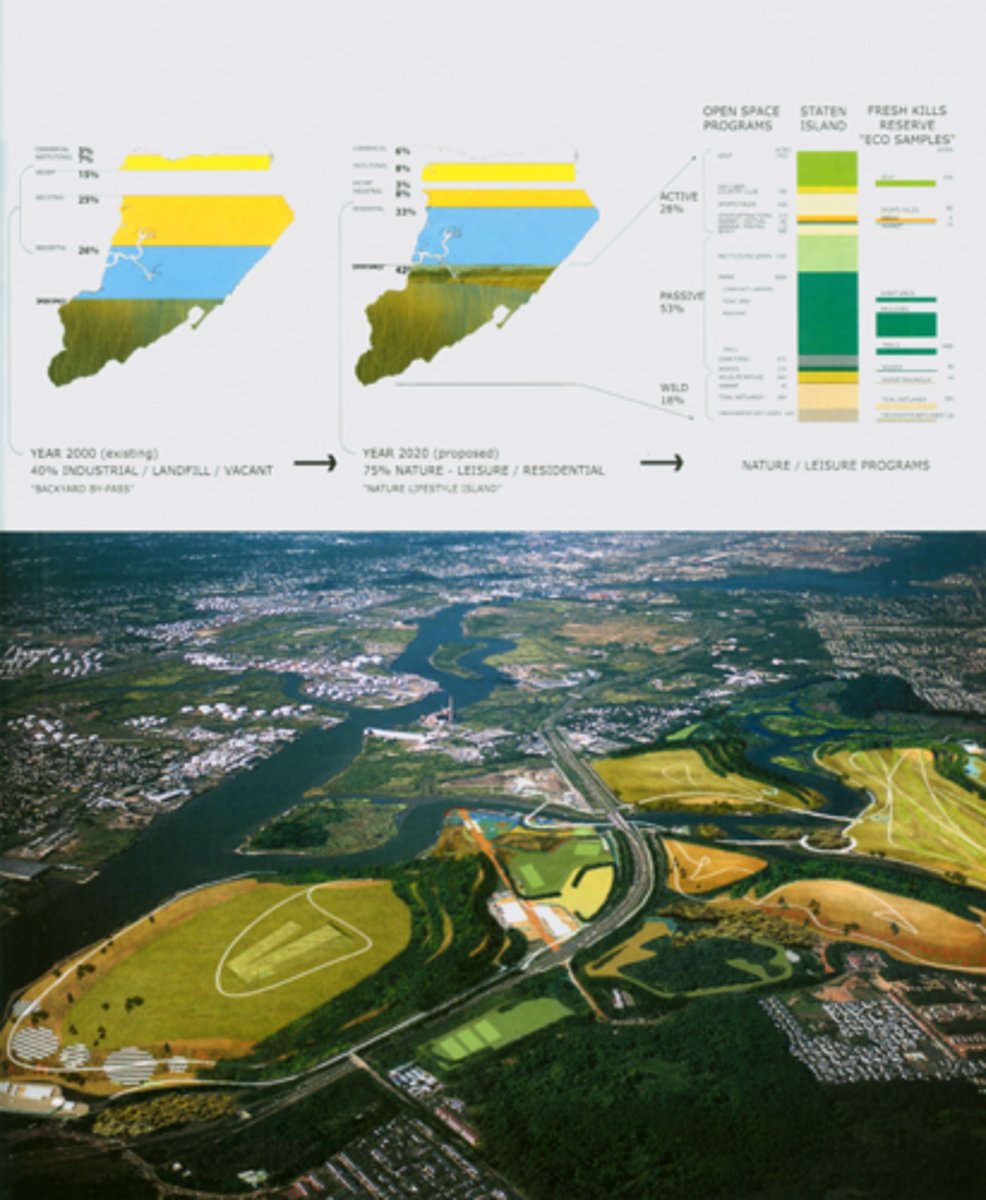
Explain the evolution of MSW disposal and differences with developing countries
How a modern landfill works:
- Liner System: The base of the landfill is lined with compacted clay and a high-density plastic liner (often HDPE) to prevent liquids from leaking into the ground
Leachate Collection: As waste decomposes and rainwater filters through, it creates a toxic liquid called leachate. Perforated pipes collect this leachate and direct it to treatment facilities, preventing groundwater contamination
Waste Compaction and Daily Cover: Trash is delivered, compacted to save space, and covered each day with soil
Gas Collection: Decomposing waste generates methane and other gases. Modern landfills use wells and pipes to collect these gases, which can be converted into electricity or heat
______
Difference Between Developed vs. Developing Countries:
- Regulations
- Landfills are engineered with multiple layers of protection and continuous monitoring. In contrast, many developing countries rely on open dumps
- Waste Collection and Segregation - highly advanced in some countries, like Japan and Sweden, but not so much in developed countries
- Global Waste Trade: Developed countries sometimes export waste to developing countries, where lax regulations can lead to environmental and health problems at local disposal sites
Explain the EPA's waste management inverted pyramid and the ecocyclemodel critique
The EPA’s waste management inverted pyramid is a visual representation of the waste management hierarchy, prioritizing actions from most to least environmentally beneficial. Top is the first thing you should prioritize, bottom is the last resort.
Reduce
Reuse
Recycle
Recovery
Disposal
Ecocycle Model Critique
The ecocycle model (sometimes called the circular economy or life cycle thinking) is a broader concept that views waste management as part of a continuous cycle, emphasizing keeping materials in use for as long as possible and regenerating natural systems.
Linear vs. Circular Thinking: The hierarchy can be seen as still somewhat linear (reduce, reuse, recycle, recover, dispose), whereas the ecocycle model stresses circularity—keeping materials in the economy and out of waste streams entirely
- Too much focus on end of life
- Limited stakeholder engagement
- There are technological barriers to the model
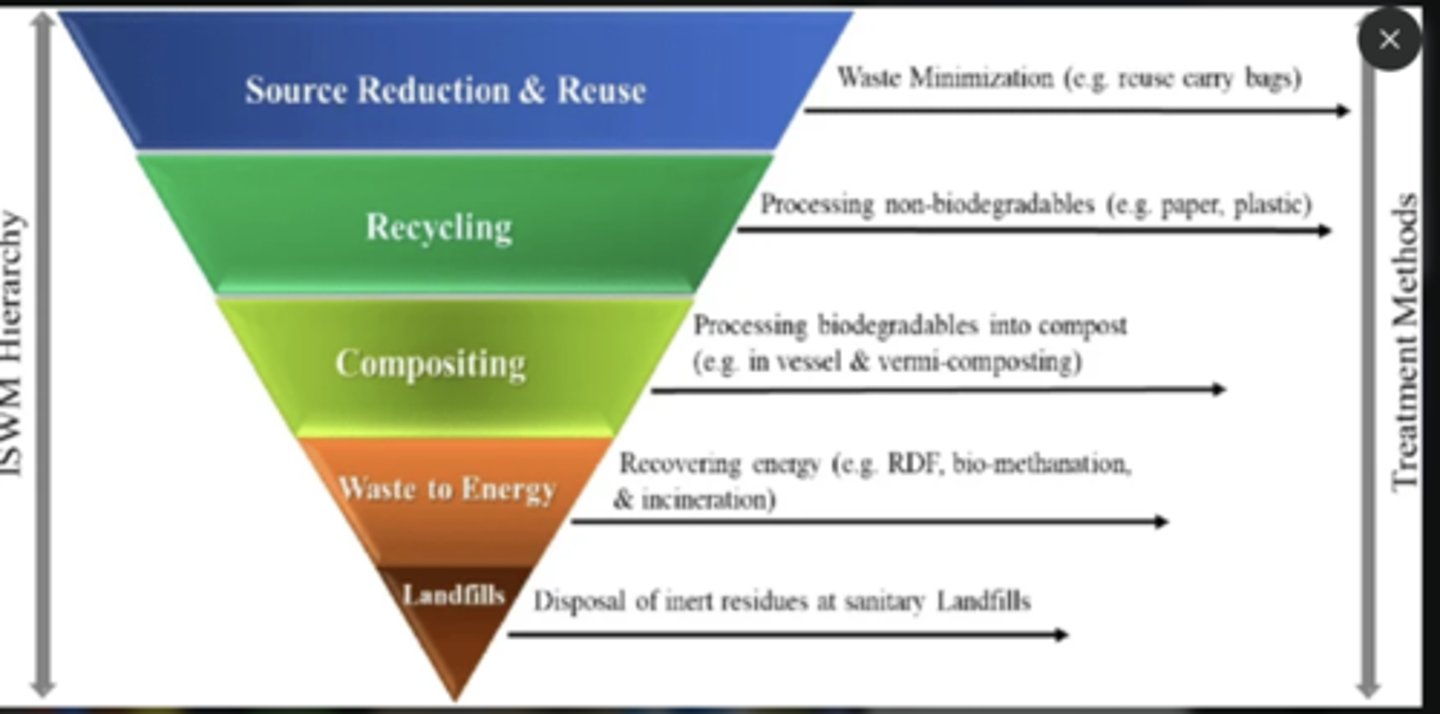
National Geographic June: Why the future of fashion is 'farm to closet'
SukkhaCitta, a fashion brand that partners with hundreds of Indonesian farmers and artisans on Java and in neighboring Bali,Flores, and West Timor.
The Indonesian fashion brand SukkhaCitta exemplifies a radical shift from fast fashion to slow, regenerative fashion
The brand emphasizes full traceability, from seed to garment, using natural, biodegradable materials and traditional, non-toxic dyeing methods.
SukkhaCitta supports regenerative agriculture (like tumpang sari), restoring soil health by planting cotton alongside crops like peanuts and chilies.
It avoids deforestation by promoting shade-tolerant indigo varietals and compostable garments.
The company pays living wages upfront, trains women in business practices, and provides land grants to rural farmers.
Fast fashion is framed as environmentally and ethically unsustainable—polluting rivers (e.g., Citarum in Indonesia) and generating mountains of textile waste.
The brand’s founder, Denica Riadini-Flesch, advocates for “scaling impact,” not profit, deliberately capping village partnerships to maintain integrity.